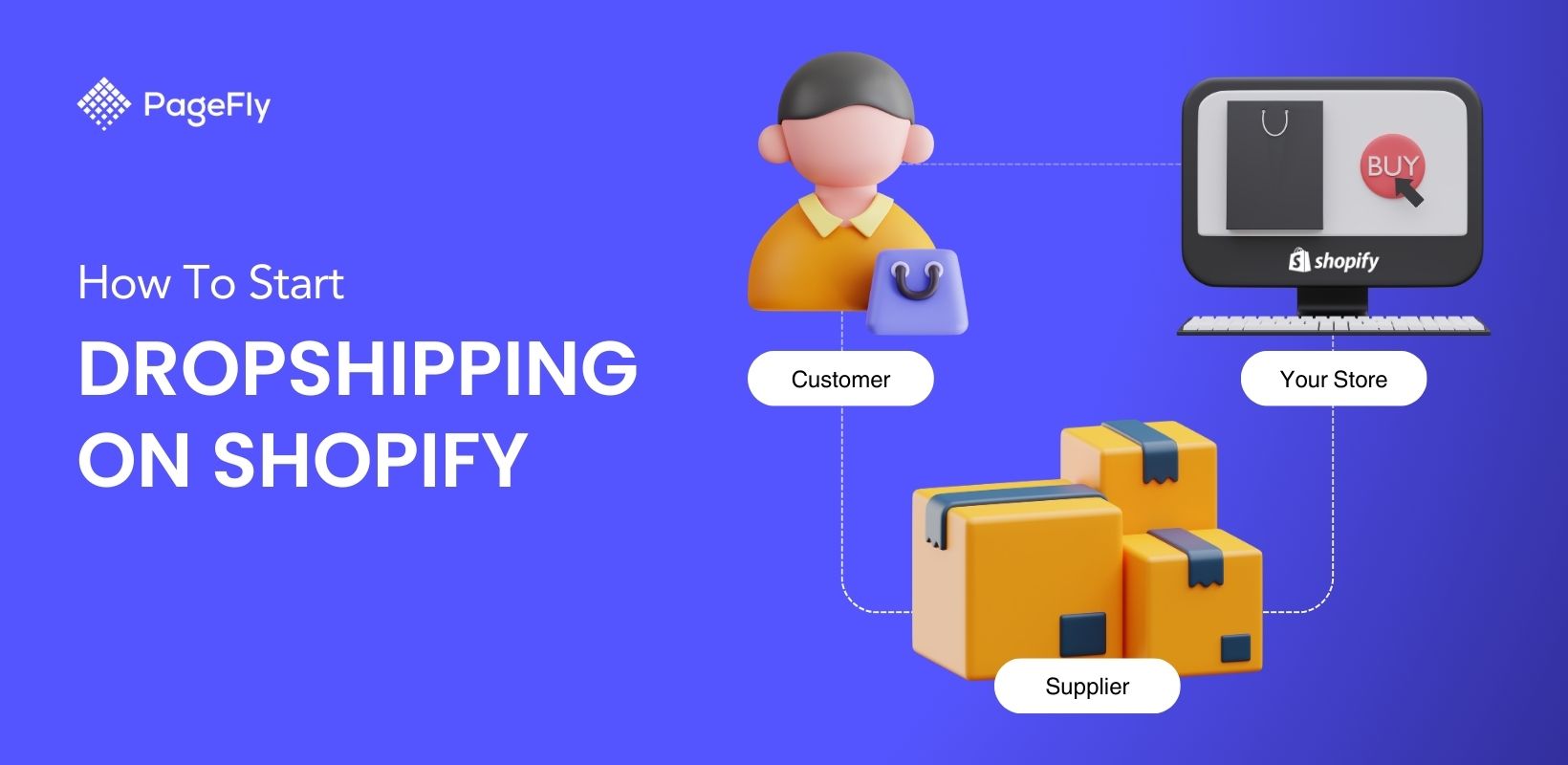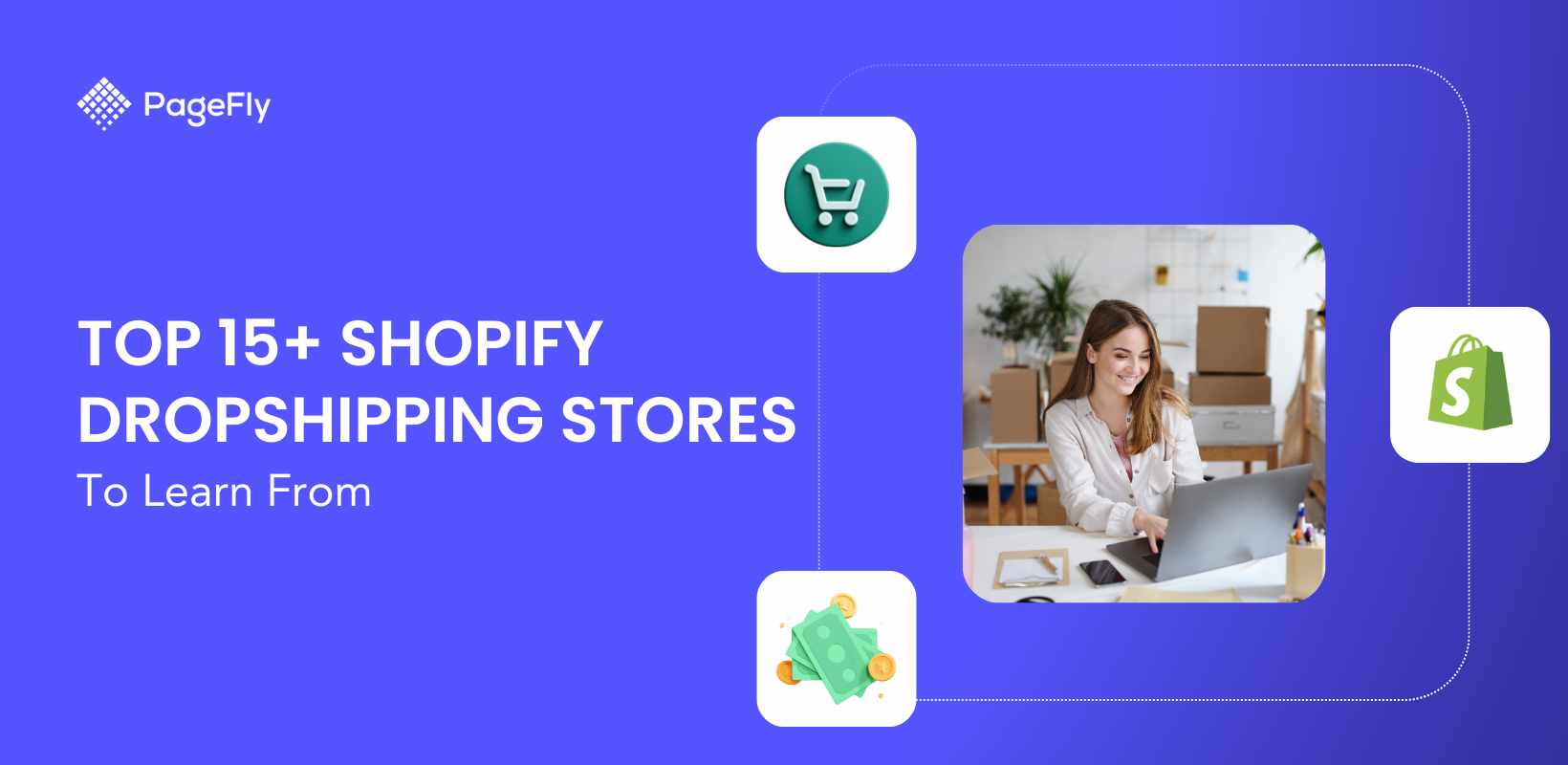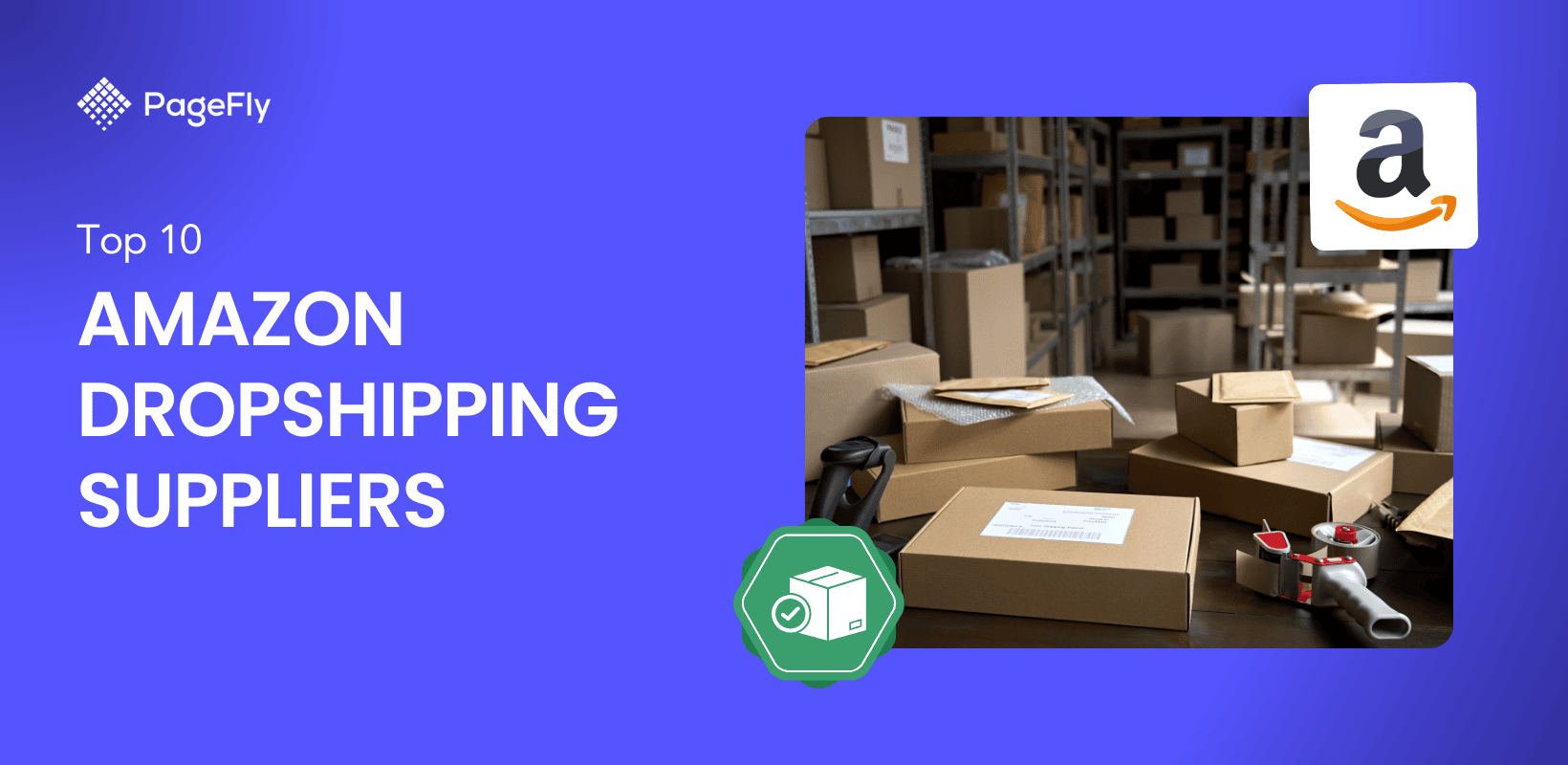Undoubtedly, eCommerce has been experiencing an unprecedented surge in recent years, and dropshipping has a prominent role in this growth.
Around 27% of retailers (source: E-DSS.org) have moved to the dropshipping model as their primary order fulfillment mode. Fascinating, right? This is just the tip of the iceberg because dropshipping is a $301 billion market right now, making it the ideal time to venture into it.
Have you ever wanted to jump on the bandwagon and learn how to start dropshipping on Shopify? We have got you covered.
The interest and demand in dropshipping are on the rise even in 2024, although the roots of this model go back to the 1960s. This article will cover everything you need to know to start a fully functioning dropshipping store on Shopify. Let's get started!
What is Dropshipping?
Dropshipping is a type of retail fulfillment method where a store doesn't have to keep the products it sells in stock.
So, how do you sell products or ship them to customers?
When a dropshipping store sells a product, it purchases the item from a third party, usually a wholesaler or manufacturer, and has it shipped directly to the customer.
In this model, the store owner acts as a middleman, making customer and supplier transactions happen.
Different Roles in Dropshipping
There are three different participants or roles in a dropshipping business:
- Store Owner: The store owner is responsible for creating and managing the online storefront; in this case, the store will be on Shopify. They are also responsible for marketing the products and handling customer inquiries and support.
- Supplier: The supplier is the entity that holds inventory and fulfills orders. They also handle product sourcing, warehousing, and shipping. They could be wholesalers, manufacturers, or other dropshipping companies specializing in fulfilling orders for online retailers.
- Customer: The customer is the end-user who purchases products from the online store. They browse products, make purchases, and receive the items directly from the supplier.
How Does a Dropshipping Fulfillment Work?
Wondering how complex or easy running a dropshipping store is or how you will fulfill the orders? Here's how it works:
- Stage 1: A customer visits your store online and places an order, selecting products and providing shipping information.
- Stage 2: The store owner (you) receives the order details and payment confirmation. You will forward the order details to the supplier.
- Stage 3: The supplier receives the order, starts processing it, packages the product, and ships it directly to the customer using the shipping information provided.
- Stage 4: The customer receives the product directly from the supplier, with the store owner's branding typically included on the packaging or shipping materials.
What are Some of the Popular Dropshipping Categories?
If you are eager to start an online store with dropshipping, it is essential to know the trending categories to benefit from this growing market:
#1 - Apparel and Footwear

Source: www.zara.com/us/
Online shopping for clothes is a common practice now. You can purchase clothes from global brands at the convenience of your home and receive the products at your doorstep. Hence, fashion is one of the highest-performing categories among dropshipping stores. This is due to the increased demand for branded products. In addition to this, this segment is expected to grow at a CAGR of 35.6% by 2031.
This category includes apparel and footwear primarily, but we have the following list as a part of this category.
- Essential short sleeve tees
- Water shoes
- Floral-print kimonos
- Quick-dry running shorts
- Golf polos
#2 - Beauty and Personal Care

Source: cerave.com/skincare
Expected to be valued at an impressive $758.4 billion by 2025 (source: Statista), the beauty and personal care industry remains among the top product segments for the dropshipping business.
This unchanging growth can be attributed to the rise of natural and organic products, which has led to the development of products such as LED face masks, cruelty-free mascara, and skincare oils.
The market is becoming more and more aware. Consumers increasingly prioritize products with clean ingredients and sustainable packaging, making this category particularly attractive for dropshippers.
#3 - Kitchen and Dining

Source: Canva
The kitchen and dining category has also witnessed a steady increase in search interest, reflecting consumers' growing enthusiasm for cooking and entertaining at home.
With an emphasis on convenience and health-conscious choices, some of the most in-demand products in this category include:
- Insulated mugs
- Water filters
- Reusable water bottles
- Air fryers
- Portable blenders, among many other products.
As more people prioritize home-cooked meals and seek innovative kitchen gadgets, dropshippers can capitalize on this trend by offering practical and stylish products that enhance the culinary experience.
Read more: Top 15+ Shopify Dropshipping Stores To Learn From In 2024 (Always Updated)
#4 - Baby Products

Source: Canva
The global baby care market is projected to reach an impressive $331.92 billion by 2029 (source: Fortune Business Insights), indicating significant growth opportunities for dropshippers.
After all, parents are always on the lookout for high-quality and safe products for their little ones, driving demand for organic baby clothing, teething toys, and hypoallergenic diaper wipes.
With many brands now focusing on sustainability and eco-friendly alternatives, this product category has gained immense popularity, especially among environmentally conscious parents.
Some of the popular products in this category are:
- Sponge bottle brushes
- Baby bottles
- Breast milk storage bags
- Booster seats
- Baby healing ointment
#5 - Pet Supplies

Source: Canva
Finally, we have pet supplies in the five best product categories for dropshipping in 2024.
The pet supplies market is thriving as pet owners prioritize the well-being and comfort of their furry companions. From rope leashes to probiotic chews, drop shippers can offer a wide range of pet accessories and essentials.
The best part of this category is that the trend toward multifunctional and fashionable products underscores the importance of style and functionality in this category.
Some products that you can consider are:
- Dog toys
- Pee pads
- Cat litter
- Pet supplements
- Treats
- Hair removers
- Harnesses
Certain research has shown that the electronics and media, furniture, and appliance categories are also some of the top-selling products in dropshipping stores. However, these categories generally require higher investment, and the lead time is also extensive.
Without saying, the electronics industry is somewhat competitive and complex, and consumers prefer buying well-known brand items in such categories. Considering the above challenges and completing product research before beginning your journey as a dropshipper is recommended.
Is Dropshipping on Shopify Profitable?

Source: Canva
Can dropshipping on Shopify be a path to financial success? The answer is a resounding maybe. It is a captivating and low-barrier entry point for aspiring entrepreneurs; however, profitability is highly volatile in this segment.
Shopify is a user-friendly eCommerce platform packed with many features to help you run a successful storefront. However, profitability depends entirely on your market segment and products,
Dropshipping businesses typically have a 15-20% profit margin (source: Printful) after considering costs such as shipping, taxes, marketplace charges, etc. At the same time, only 1.5% of stores achieve $50K profit or more in a month. While the former might be good news, achieving such profit margins might only be possible in the long run.
Here are a few tips to keep in mind for a profitable dropshipping journey with Shopify:
- Source high-quality products with reasonable markups from reputable suppliers
- Negotiate favorable terms with suppliers to reduce costs and optimize profit margins
- Continuously adjust pricing strategy to remain competitive while ensuring profitability
- Set up detailed processes and renegotiate contracts to reduce operational expenses
- Offer value-added services to differentiate your business and justify higher prices
- Implement upselling and cross-selling techniques to increase average order value and boost profits
- Invest in customer retention through excellent service and loyalty programs
- Analyze marketing ROI to allocate resources effectively
Profitability in dropshipping is directly tied to niche selection. Choosing the right niche can make or break your venture. Niches with high demand and relatively low competition offer the best prospects for profitability.
So, how do you find your niche? Intensive market research is the way to go about it. Plenty of tools, such as Niche Scaper, Dropship Spy, etc., can help you in your market research.
Pro Tip: Negotiate bulk discounts with suppliers to further boost your margins.
The good old way of doing manual research also doesn't hurt. You can even use social media platforms to connect with your target audience and use tools such as Spocket to find the products for you to sell.
Remember, competitive pricing is key. Don't undersell yourself, but don't scare customers away either.
Quick read: How To Define “Sell This Now” Products To Dropship On Shopify (+ Top 6 Winning Products In 2024)
How to Start Dropshipping on Shopify With No Money
Starting dropshipping on Shopify with no money can present a challenge, but with strategic planning and resourcefulness, launching your business without breaking the bank is possible.
Here are practical strategies to minimize startup costs:
Use Free or Affordable Shopify Themes

Shopify Themes Store has a ton of free and paid themes available. You can choose the one you prefer based on the design, features, and price. If you choose a free theme (e.g., Dawn, Sense, Spotlight), you don't have to invest further into designing your store; you can just customize it as you like.
If you're willing to invest a small amount, consider purchasing a premium theme with advanced features for a one-time fee. A few we recommend that require a low investment include:
- Responsive
- Vision
- Woodstock
- Combine
Make use of Free or Trials of Dropshipping Tools

Take advantage of free trials offered by dropshipping tools and apps available on the Shopify App Store. Platforms like Spocket, DSers, etc., come with free basic plans in addition to a free trial. This allows you to test their functionality and compatibility with your dropshipping business model before committing to a paid subscription.
Explore Print-on-Demand (POD) Models

Printful and Printify are popular print-on-demand dropshipping services that allow you to sell custom-designed products without holding inventory. Plus, they are available on the Shopify Apps Store, making it easy for you to integrate them into your storefront, import product listings, and sell.
There are no upfront costs or minimum order requirements; you can create and sell custom merchandise such as apparel, accessories, and home decor items, paying only for each item as it's sold. Plus, they run multiple offers throughout the year, so keep an eye out it for the same.
Pro Tip: Instead of offering a wide range of products from the outset, consider starting with a curated selection of items to minimize upfront investment in inventory.
Free Marketing Channels

Source: Canva
Even in 2024, many social media platforms are free to use. Instagram, Facebook, and TikTok are bustling marketplaces for businesses to promote and sell their products. You, too, can make use of this opportunity to promote your store and products to attract potential customers. Plus, writing content on your store and utilizing social media can help you gain visibility on search engines, too, driving organic traffic to your store.
Don't forget to optimize your website for search engines by incorporating relevant keywords, creating compelling content, and building backlinks to improve your visibility in search results.
How to Set Up Dropshipping on Shopify?
Ready to start a Shopify dropshipping store? Here's a detailed guide to help you get started:
Step 1: Choosing a Niche and Target Audience:
- Research different niches to identify one that aligns with your interests, expertise, and market demand.
- Consider the profitability and competition within each niche.
- Define your target audience based on demographics, interests, and purchasing behavior.
Step 2: Selecting Winning Dropshipping Products
- Conduct market research to identify trending products with high demand and low competition.
- Look for products that offer good profit margins and solve a specific problem or fulfill a need for your target audience.
- Consider using tools like Google Trends, Amazon Best Sellers, WinningHunter, or other platforms for product ideas.
Step 3: Finding Reliable Dropshipping Suppliers
- Research potential suppliers thoroughly, looking for factors like product quality, shipping times, and customer service.
- Use dropshipping directories such as SaleHoo, Worldwide Brands, or Oberlo to find reputable suppliers in your chosen niche. You can also consider some of the top dropshipping suppliers, such as Alibaba and AliExpress.
- Reach out to multiple suppliers to compare pricing, terms, and available inventory.
Pro Tip: If you have the budget, consider using a tool like DSers. It helps automate tasks and makes order management more efficient. If AliExpress is your dropshipping supplier, then you can effortlessly scale your business with this app.
Step 4: Setting Up Your Shopify Store

- Sign up for a Shopify account and choose a suitable pricing plan. Currently, Shopify offers a 3-day free trial, and you can choose a plan after that.

- Once you have signed up and are on the Shopify Admin page, based on your choices (in the image above, we have picked dropshipping business and POD models), you will get the option to add and install several dropshipping and POD apps. Click on "Find products to sell' to find these apps.

- Go to settings -> domains, and buy a new domain name or connect your existing one.

- To customize or update your theme, click on themes at the online store. Explore free or affordable Shopify themes to design your store's layout and appearance, ensuring it reflects your brand identity and appeal to your target audience.

- Also, payment gateways such as PayPal, Stripe, or Shopify Payments can be configured to accept online payments securely in the settings.
Step 5: Adding Products and Writing Compelling Descriptions
- Use Shopify's product management tools to add products to your store, including images, titles, descriptions, and pricing. You can also do this manually, but we recommend the above to save time.
- Write compelling and persuasive product descriptions highlighting each item's benefits, features, and unique selling points. Use ChatGPT or similar tools to get this done.
- Optimize product titles and descriptions for keywords to improve visibility and attract organic traffic.
Finally, you can hit that publish button, and your site will be live and ready to sell.
Start Dropshipping on Shopify Today!
Setting up a dropshipping store on Shopify can seem daunting and fruitful at the same time. While the dropshipping business model is gaining a lot of attention in this year, starting a store should be backed with detailed and careful planning, strategic decision-making, and continuous optimization.
With all the information we shared in this article, you can take action today to start building your Shopify dropshipping empire. So, good luck!
Explore more, check out: CJ Dropshipping Shopify: Review & How to Get Started











